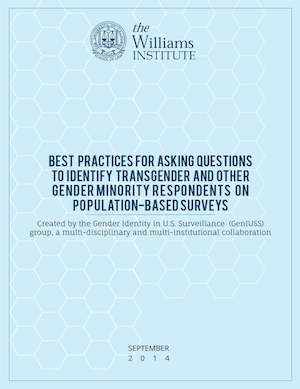In order to count in our society, we have to be counted.
Take the U.S. Census, which is completed every 10 years. Results of the Constitutionally-mandated, decennial survey inform the outlines of Congressional Districts and allocations of billions of dollars in federal aid to states and local municipalities. Data from demographic questions related to race, sex, and age, meanwhile, that have been added to the Census over the years are used to inform policy and funding decisions aimed at ending discrimination and reducing health inequities.
Currently, there are no transgender-inclusive questions about gender identity on the Census or other massive, publicly-funded surveys. The need for the inclusion of transgender people and other gender minorities on the National Crime Victimization Survey, for example, should be obvious. Numerous surveys of transgender people show that gender minority people are the victims of violence at rates much higher than the general population. “Injustice at Every Turn: A Report of the National Transgender Discrimination Survey” found that 61 percent of respondents reported they had been the victim of physical assault while 64 percent reported having been sexually assaulted.
The same holds true for the need for transgender-inclusive questions on the national Survey of Income and Program Participation. Employment discrimination has led to high rates of un- and under-employment of gender minorities. Here in Massachusetts, transgender adults are three times more likely to be unemployed and three times more likely to be living in poverty than adults who are not transgender.
Wide scale interventions designed to reduce discrimination against transgender people are unlikely to happen unless the Census, the National Crime Victimization Survey, and other large population-based surveys include transgender and gender minority-inclusive questions.
 One of the practical obstacles to inclusion is lack of understanding about how to best collect the data. It is not as easy as simply asking respondents to check off a box stating that they are transgender.
One of the practical obstacles to inclusion is lack of understanding about how to best collect the data. It is not as easy as simply asking respondents to check off a box stating that they are transgender.
Researchers have found that some people in the general population do not understand what the term “transgender” means and may inaccurately check the transgender box, resulting in an overcount. Meanwhile, many transgender people identify as either “male” or “female” and may not check off a box marked “transgender,” resulting in an undercount. So there is a need to either define the term transgender and/or to ask questions such as what sex the respondent was assigned at birth and what gender they currently identify with.
In a new report released this week, The Gender Identity in U.S. Surveillance Group (GenIUSS) recommends guidelines for how to assess individual characteristics such as gender identity, sex assigned at birth, and transgender status on public surveys. It’s a vitally important first step toward collecting the information we need to ensure that transgender and other gender minority people count in our country.
Kerith Conron, ScD is a Research Scientist at The Fenway Institute, a GenIUSS Steering Committee member, and a co-author of the GenIUSS report on how to include transgender people in national surveys.









